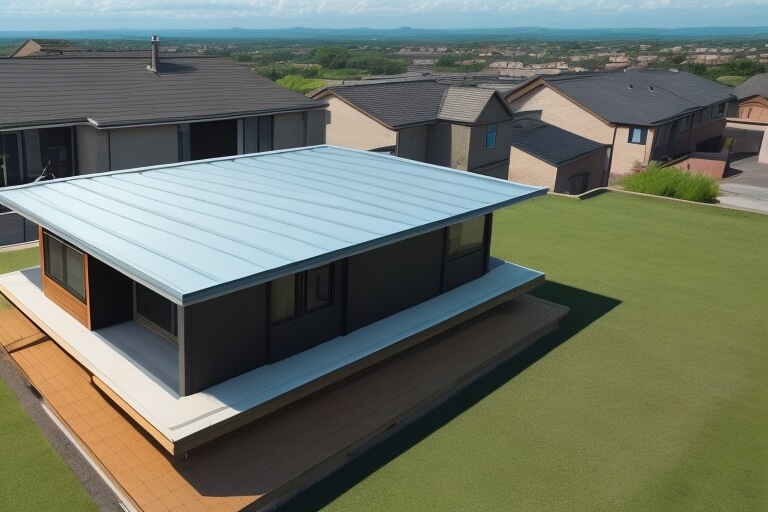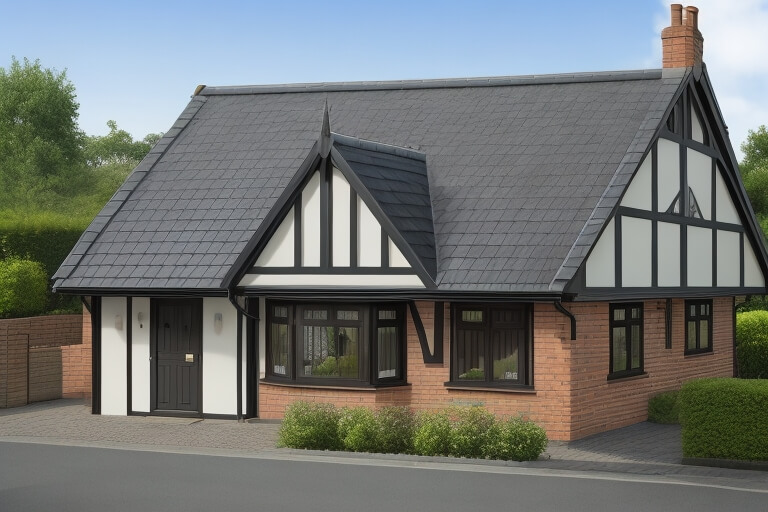When it comes to roofing options, homeowners are often faced with the decision between flat roofing and pitched roofing. Each type has its own set of advantages and disadvantages, making it essential to understand the key differences before making a choice.
Flat Roofing Overview
Flat roofing is a contemporary roofing solution known for its sleek and modern aesthetics. Unlike the traditional pitched roof, flat roofs have a horizontal or nearly horizontal design. This architectural choice has gained popularity in recent years due to its clean lines and space efficiency.
 Flat roofing boasts a range of benefits and drawbacks that homeowners should thoroughly evaluate before reaching a decision. Firstly, one of the key advantages of flat roofing is its efficient use of space. The flat or nearly horizontal design of these roofs offers valuable additional living space. Homeowners can convert their flat roofs into various functional areas such as rooftop gardens, outdoor lounges, or even accommodate solar panel installations. This spatial flexibility is particularly beneficial in densely populated urban areas where space is at a premium.
Flat roofing boasts a range of benefits and drawbacks that homeowners should thoroughly evaluate before reaching a decision. Firstly, one of the key advantages of flat roofing is its efficient use of space. The flat or nearly horizontal design of these roofs offers valuable additional living space. Homeowners can convert their flat roofs into various functional areas such as rooftop gardens, outdoor lounges, or even accommodate solar panel installations. This spatial flexibility is particularly beneficial in densely populated urban areas where space is at a premium.
Flat roofing is renowned for its sleek and contemporary aesthetics. The clean lines and minimalist design of flat roofs can significantly enhance a house’s overall appearance, imparting a modern and sophisticated look. This aesthetic appeal caters to homeowners who seek a stylish architectural style that aligns with their preferences.
In terms of maintenance, flat roofs have a practical advantage. They are typically easier to access and maintain compared to pitched roofs. Homeowners can conveniently reach the roof for routine upkeep tasks, including debris removal, damage inspections, and minor repairs. This accessibility makes it feasible to extend the roof’s lifespan and ensure its durability over time.
On the flip side, flat roofing does come with certain challenges that necessitate careful consideration. One notable issue is drainage. Flat roofs have a propensity to accumulate water, which can lead to leakage or structural issues if not managed effectively. Proper drainage systems, such as scuppers, downspouts, or tapered insulation, are essential to ensure adequate water runoff. Vigilant maintenance of these systems is crucial to avert water-related problems.
Another drawback to be mindful of is the potential shorter lifespan of flat roofing materials when compared to certain pitched roofing options. This is especially true when inferior materials are used or if the roof undergoes insufficient maintenance. To maximize the longevity of a flat roof, it is imperative to invest in high-quality materials and adhere to a regular maintenance regimen. Neglecting these aspects can result in premature wear and tear, culminating in costly repairs.
Lastly, flat roofs may require extra attention to insulation and energy efficiency. The absence of a natural slope can make them more prone to heat retention, which might lead to increased energy bills. Adequate insulation and ventilation are essential to maintain a comfortable living environment while preventing moisture buildup, which can foster mold and mildew issues.
Pitched Roofing Overview
Pitched roofs, characterized by their sloping design, have been a staple in architectural history. This classic roofing style is not only aesthetically pleasing but also offers various advantages.
 Pitched roofs excel in weather resistance. Their sloped design allows rain and snow to shed quickly, preventing water from pooling and causing leaks. This feature makes pitched roofs particularly suitable for areas with heavy precipitation, where effective drainage is essential.
Pitched roofs excel in weather resistance. Their sloped design allows rain and snow to shed quickly, preventing water from pooling and causing leaks. This feature makes pitched roofs particularly suitable for areas with heavy precipitation, where effective drainage is essential.
Durability is another key benefit of pitched roofing. Many roofing materials commonly used for pitched roofs, such as asphalt shingles, metal, or tile, are highly durable and can withstand harsh weather conditions and UV radiation. This durability can lead to long-lasting protection for your home.
Pitched roofs also provide natural ventilation, which helps regulate the temperature in the attic and prevents moisture buildup. This ventilation can contribute to a more comfortable living environment and reduce energy costs.
However, there are downsides to consider with pitched roofing as well. Cost is one significant factor. The installation of pitched roofs can be more expensive initially due to the complexity of the design and the materials involved. This cost can be a deterrent for budget-conscious homeowners.
Pitched roofs do not offer the same level of usable space for rooftop features like gardens or solar panels when compared to flat roofs. If maximizing rooftop space is a priority, this limitation may influence your decision.
Environmental Considerations
Environmental concerns play a significant role in the decision-making process when it comes to choosing between flat roofing and pitched roofing. Both roofing options have distinct implications for the environment.
Flat roofing can be an environmentally friendly choice when designed with sustainability in mind. One of the standout features of flat roofs is their adaptability to support green roofing systems. Green roofs, also known as living roofs, involve the cultivation of vegetation atop the roof structure. These green spaces not only enhance the aesthetics of your home but also provide a range of environmental benefits.
Firstly, green roofs act as natural insulators, regulating the temperature of the building beneath them. This reduces the need for energy-consuming heating and cooling systems, ultimately decreasing your home’s carbon footprint. Additionally, green roofs absorb rainwater, reducing stormwater runoff and the risk of localized flooding. This, in turn, helps protect the quality of nearby water sources and minimizes soil erosion.
Flat roofs are often well-suited for the installation of solar panels. Harnessing solar energy can significantly reduce your reliance on non-renewable energy sources, further contributing to a more sustainable lifestyle. By choosing flat roofing and incorporating solar power into your home, you can make a substantial positive impact on the environment.
The environmental impact of pitched roofing largely depends on the materials used for construction. While some roofing materials, such as asphalt shingles, can be recycled, others may end up in landfills at the end of their lifespan. It’s essential to consider the environmental implications of your chosen roofing material.
Metal roofing, for example, is highly sustainable and recyclable. Choosing this material can significantly reduce the demand for raw resources and reduce waste. Similarly, some types of roofing tiles are made from recycled materials, providing an eco-friendly option for homeowners.
In addition to material choices, pitched roofs can contribute to energy efficiency and environmental sustainability through proper insulation and ventilation. These factors help regulate indoor temperatures and reduce the need for excessive heating or cooling. In turn, this leads to lower energy consumption and a reduced carbon footprint.